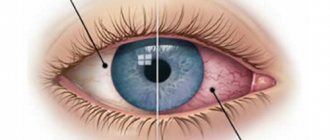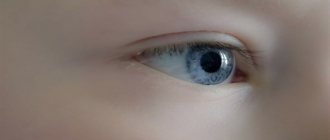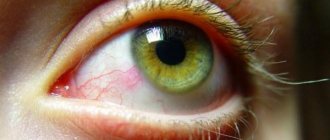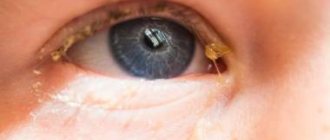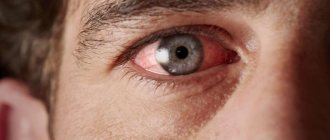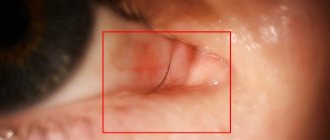The surface of the eye is always covered with a tear film. It consists of fatty, aqueous and mucous layers. During the day, they are washed away by tears during blinking, and at night they accumulate, harden and turn into crusts. Mucus in the corners of the eyes is common. But a change in its color or consistency may indicate the development of the disease.
Mucus in the eyes in the morning is a consequence of the functioning of the lacrimal glands, due to which the surface of the eyeball is moistened and cleansed of impurities. But in some cases, this phenomenon is a sign of an eye disease. Please pay attention to:
- localization of mucus and crusts;
- frequency of discharge;
- color and consistency;
- the amount of secretion released;
- presence of other symptoms: irritation, itching, etc.
Let's look at some diseases in which mucus accumulates in the corners of the eyes.
Why is there white discharge from the eyes?
Most often, white discharge can accumulate on the skin at the base of the eyelashes and in the corner of the eye socket. In some cases, purulent discharge from the eyes is an allergic reaction to some irritant. Sometimes the symptom that appears is caused by an infection in the organ of vision.
The discharge is not only white. They can vary significantly in consistency and color. When dry, some of them form crusts. Sometimes they stick the eyelids together so much that it is very difficult to open them without water.
Discharge from the eye
The eyes of an adult can become inflamed as a result of the development of certain diseases that affect the organs of vision. Blepharitis is the most common eye disease. The causes of this pathology are as follows:
- Excess secreted subcutaneous fat.
- Using low quality cosmetics.
- Allergies caused by the use of cosmetics.
- Demodex mite.
- Viral infection.
- Dust and dirt that have entered the organ of vision. In this case, the secretion can be released especially intensely in the morning.
With blepharitis, the accumulated discharge is purulent in nature and is particularly thick. The eyelids become very red and swollen. There is severe lacrimation.
The next disease, accompanied by purulent discharge from the orbit, is called conjunctivitis and there are several types: adenoviral conjunctivitis, which is caused by a viral infection, and allergic.
Both forms are accompanied by discharge from the orbits. During the night, the eyelids become heavily stuck together with pus.
Types of conjunctivitis
But the discharge does not always have a thick consistency. Very often liquid transparent mucus appears. Such discharge does not dry out and does not form a crust. They can appear as a result of an allergic reaction or a cold. In this condition, patients complain of:
- blurred vision;
- painful reaction to light;
- itching and burning in the cornea;
- profuse lacrimation.
With a cold, in addition to discharge from the eyeballs, coughing, fever, runny nose and sneezing are observed. The cause of discharge from the orbit lies in a bacterial or viral infection.
As soon as general recovery occurs, the discharge from the eyes will disappear. In this case, the symptoms of the disease will be the same in both adults and children.
Purulent damage to the organ of vision can also occur for other reasons, for example, as a result of foreign objects entering the eye or due to injury.
Discharge from the eye that is yellow or brown in color is characteristic of:
- bacterial conjunctivitis;
- herpes;
- trachoma;
- fungal keratitis.
A yellowish tint indicates an infectious origin of the problem. In the process of many eye diseases, a large number of dead cells and metabolites accumulate, and it is these that the body tries to get rid of in the form of pus.
Pus is also released during the ripening process of barley. In this case, the abscess ripens very slowly and then bursts with the release of thick pus.
According to statistics, purulent eye lesions are most often diagnosed in children and the elderly. White discharge in the corners of the eyes can be the first signal indicating the presence of infection in the body.
Why do children have discharge in their eyes? In children, such discharge is one of the symptoms of dacryocystitis. The essence of this pathology is blockage of the tear ducts. In this case, yellow discharge is observed, which accumulates there and is released with light pressure.
Most often, this pathology occurs in newborns. Blockage of the tear ducts occurs due to the anatomical structure of the eyeball in very young children. But it is not the ophthalmologist, but the otolaryngologist who treats the tear ducts and washes them. Sometimes the problem with the tear ducts is so serious that it is necessary to seek the help of a surgeon.
Causes of the unpleasant syndrome
Discharge from the eye becomes a protective reaction of the body to the effects of aggressive environmental factors. It could be an infection, an allergen, or mechanical damage. In most cases, they suggest that a person, and in particular his organs of vision, are affected by one or another ailment.
What diseases can discharge from the eye indicate:
- conjunctivitis (allergic, bacterial or viral);
- dacryocystitis;
- trachoma;
- blepharitis;
- keratitis.
Discharge is also possible when an infection penetrates into the organ of vision, weakened by surgery, during the rehabilitation period. Uncomfortable or dirty lenses can also cause an unpleasant symptom. Discharge from the eyes of a person can appear when exposed to chemicals and ultraviolet radiation, as a result of long work at the monitor due to dryness and fatigue of the visual organs.
Inflammation of the conjunctiva most often causes a similar symptom. The cause may be infection of the organs of vision with pathological bacteria and viruses or a reaction to an allergic irritant. This disease can lead to serious consequences in the form of endophthalmitis or corneal ulcers. Inflammation of the lacrimal sac or dacryocystitis is caused by dysfunction of the nasolacrimal ducts, which provokes congestion in the eye. Trachoma, that is, a chronic inflammatory process in the conjunctiva and cornea, is caused by chlamydial infection. With keratitis, the cornea becomes inflamed for infectious reasons.
Blepharitis, manifested by inflammation of the ciliary edge of the eyelids, may have several causes:
- excessively oily skin;
- low-quality cosmetics;
- reaction to demodex dust mites;
- infections of neighboring organs or brought from contaminated objects.
Discharge from the eye is usually accompanied by additional unpleasant symptoms:
- cloudiness, burning and itching in the organs of vision
- painful sensation and increased lacrimation;
- redness, swelling, photosensitivity.
With bacterial or viral lesions, cough, runny nose, aching sensations in the joints, and fever are also possible.
Discharge from the eyes accompanying a certain disease can lead to serious complications, including loss of vision. And if they do not go away quickly or are accompanied by severe itching and pain, you should definitely consult an ophthalmologist.
What to do if there is discharge from the eyes?
It is not recommended to treat eye discharge on your own, especially in a child. After all, parents cannot always know exactly what caused the released pus. When the first discharge appears in the morning, you should immediately consult a doctor.
Reddened mucous eyes are one of the symptoms of incipient inflammation. The discharge of pus from the eyes in both an adult and a child should be a serious reason to consult a doctor.
In adults, such symptoms usually do not cause much concern, so they try to treat themselves or simply ignore the problem. There are different reasons for the appearance of pus from the eyes, and treatment should be selected individually. .
If a visit to the doctor needs to be postponed for some time for serious reasons, you can temporarily use one of the folk recipes.
- To do this, brew a decoction of chamomile flowers and wash the eye sockets with it.
- In this case, a decoction of rowan fruits can also alleviate the patient’s condition.
- If there are no these herbs in the house, then you can apply a cotton swab dipped in a solution of furatsilin or potassium permanganate to your eyes.
- The most common boiled water or tea leaves will do.
- Some sources recommend rinsing pus out of the eyes with a weak saline solution.
- If pus appears after using new cosmetics, then the cause could be an allergic reaction, which means that you must first stop using it.
But in any case, all these measures can only temporarily relieve unpleasant symptoms, manifested in the form of pus discharge. They cannot eliminate the real cause of the disease, so a visit to the doctor is mandatory. Currently, many drugs have been developed that can quickly relieve this condition.
People who spend a lot of time at the computer often report that they have white discharge from their eye sockets. Severe strain on the eyes, accompanied by redness of the mucous membrane, may cause an involuntary desire to rub the eyes with your hand to relieve tension.
At this point, dirt or infection may enter the organ of vision. But in any case, only a doctor can determine the cause of the problem by carefully examining the mucous membrane and tear ducts.
If you do not consult a doctor in time, then, for example, conjunctivitis from an acute form can become chronic, especially if it is caused by Staphylococcus epidermidis. Typically, the symptoms of this pathology are redness of the mucous membrane, especially in the evening, and the appearance of white discharge in the corners of the eyes.
It is much more difficult to cure chronic conjunctivitis than acute conjunctivitis; antibiotics are sometimes prescribed. Very often, along with damage to the organ of vision, it is necessary to treat a chronic runny nose along with the maxillary sinuses.
Treatment
Therapeutic tactics involve influencing the source of the problem and the mechanisms of pathology development. Basically, this can be achieved using conservative methods. They cannot do without medications:
- Antiseptics (Albucid, Vitabact).
- Antibiotics (Tsipropharm, Tobrex, tetracycline ointment).
- Non-steroidal anti-inflammatory drugs (Indocollir).
- Antiallergic (Lecrolin, Visallergol).
- Glucocorticoids (hydrocortisone ointment).
When you have a cold, it is important to increase the activity of the body's defenses, for which interferon preparations (Nazoferon), immunomodulators (Anaferon, Polyoxidonium), and vitamins (ascorbic acid) can be used. Dacryocystitis during the period of infiltration is also treated with physiotherapy (UHF therapy, dry heat). And if an abscess forms, surgical methods will have to be used, because the pathological exudate must be removed from the lacrimal sac. This is done by creating an anastomosis between it and the nasal cavity (dacryocystorhinostomy). Currently, the operation is performed minimally invasively (endoscopically or laser).
If there is discharge from the eyes, then the only correct solution is to seek help from a doctor. Only a specialist can understand the cause of the changes and how to eliminate the pathology. And the patient should refuse even the thought of self-medication, and rely on medical recommendations in everything.
Treatment of purulent discharge from the eyes
In any case, all experts say that treatment of purulent inflammation of the eyes in a person should be carried out on an individual basis. The doctor will first conduct a comprehensive examination and find out the cause of the pus, and also determine the type of infection that led to the formation of discharge. Only after this will effective treatment be prescribed.
The formation of pus in any area, including the eyes, indicates that the body is actively fighting infection through a large number of leukocytes, and such manifestations of the disease cannot be ignored.
If it is not possible to see an ophthalmologist at your place of residence, you can visit one of the specialized clinics that treat diseases of the visual organs.
Prevention
Prevention is always easier than cure, so let's look at some simple measures that can be taken to prevent discharge from occurring in the first place:
- Protect your eyes. Try to avoid injuring them and getting foreign substances into them as much as possible.
- Treat your body. Even a prolonged cold can provoke discharge, so be sure not to delay treatment of diseases.
- Limit eye strain. To prevent dry eye syndrome from developing, reduce your load.
Read about red spots under the eyes here.
